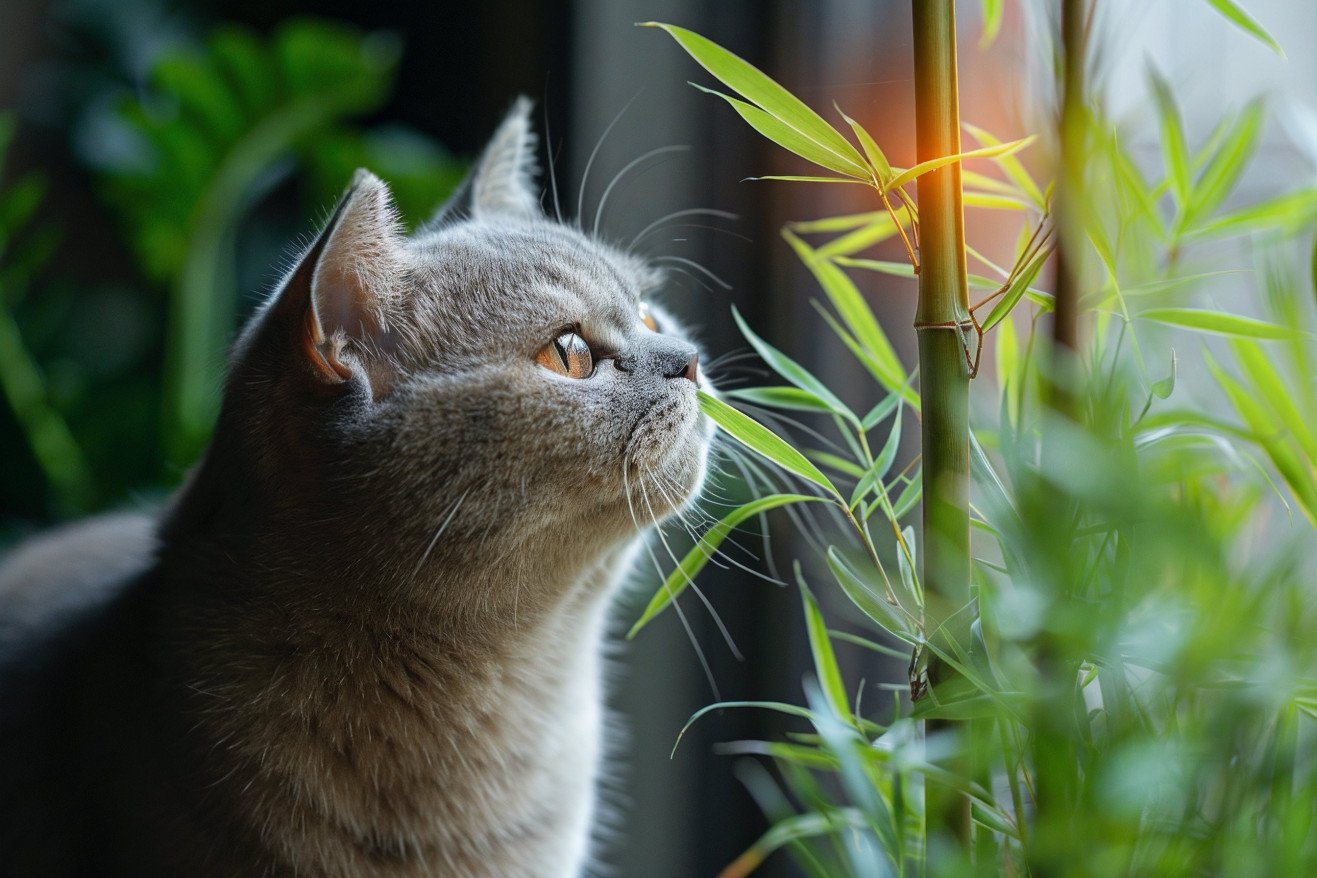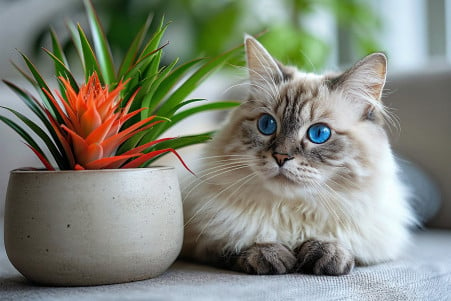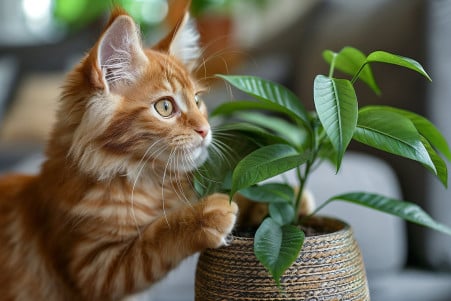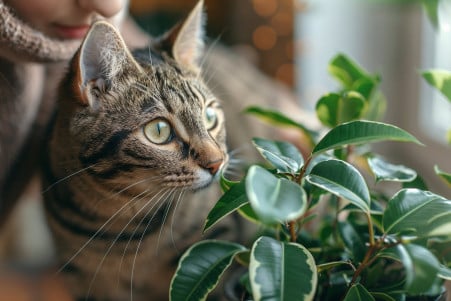Is Bamboo Toxic to Cats? Separating Safe Plants from Dangerous Look-Alikes
17 February 2024 • Updated 16 February 2024

Pet parents love their cats, but could a seemingly harmless bamboo plant be a threat to their health? True bamboo is not toxic to cats, so it’s safe to have in your home if you have a cat. However, Lucky Bamboo and Heavenly Bamboo are not true bamboo and are toxic to cats.
In this article, we’ll investigate the safety of bamboo for cats, drawing on a range of studies and expert information from the fields of veterinary medicine, botany, and pet care.
We’ll discuss research that has investigated the chemical makeup of different species of bamboo, the impact of bamboo on cats, and how to tell the difference between true bamboo and its toxic imposters. By looking at this research from multiple disciplines, we hope to offer a well-rounded view of which houseplants you can safely keep in your home with your inquisitive feline friends.
Is bamboo toxic to cats?
Real Bamboo vs. Poisonous Imposters
Knowing what real bamboo is can help us understand how safe it is for our cats. Botanically, bamboo is part of the grass family Poaceae, which is characterized by its fast growth, hardy wood, and segmented structure.
Real bamboos, like those in the Phyllostachys genus, are some of the most common and diverse bamboos. The species in this genus range from the cold-hardy Phyllostachys nuda to the Phyllostachys edulis ‘Moso’, which can grow up to 75 feet tall, according to Lewis Bamboo.
On the other hand, plants like ‘Lucky Bamboo’ (Dracaena sanderiana) and ‘Heavenly Bamboo’ (Nandina domestica) are not real bamboos. Even though they may look like real bamboo with their upright growth and segmented structure, they have different botanical features and toxicity levels. The fact that real bamboo, such as Phyllostachys nigra ‘Black’, is non-toxic means that cat owners don’t have to worry about their cats getting sick if they eat these plants.
Knowing how to identify real bamboo can help you avoid accidentally poisoning your cat with these potentially dangerous plants that look like real bamboo. Differentiating between bamboo species involves looking at details like the type of rhizome, the height of the culms, and the shape of the leaves, according to Natalie Schneider of the American Bamboo Society.
By learning these botanical details, cat owners can make sure their cats are safe from the poisonous effects of bamboo imposters and create a safe environment for their pets.
Toxicity of ‘Lucky Bamboo’ and ‘Heavenly Bamboo’
While real bamboo is not toxic to cats, the similarly named ‘Lucky Bamboo’ (Dracaena sanderiana) and ‘Heavenly Bamboo’ (Nandina domestica) are both toxic to cats.
According to the Practical Planter, both of these plants contain toxic substances that can be very harmful to cats if they are ingested.
‘Lucky Bamboo’, which is often sold as a houseplant and can be grown in water, contains saponins, which are known for their irritating and potentially hemolytic effects. As a result, cats that have been poisoned by ‘Lucky Bamboo’ may experience symptoms like diarrhea and vomiting, as well as more serious symptoms like seizures, respiratory failure, and weakness.
On the other hand, ‘Heavenly Bamboo’ is dangerous because it contains taxiphyllin in its shoots, which can lead to cyanide poisoning in cats.
Cats that have been poisoned by Nandina domestica may show signs like drooling, panting, and a loss of appetite. It is important to be able to recognize these symptoms so that you can get your cat to the vet as quickly as possible to help them avoid the toxic effects and recover.
Why Are Houseplants Toxic to Cats?
Cats are naturally inquisitive animals, and this curiosity often leads them to chew on houseplants. Unfortunately, many plants are toxic to cats and contain compounds that can harm them. A paper in PMC explains that plants produce secondary metabolites as a defense mechanism against herbivores. While these compounds help the plant, they can be toxic to animals, including cats. Alkaloids, glycosides, and saponins are some of the compounds that can cause toxicity.
Cats can experience a variety of symptoms from plant toxicity, and the severity of these symptoms can also vary. Common clinical signs of plant toxicity, including gastrointestinal and neurological symptoms like vomiting, diarrhea, lethargy, and disorientation, are listed in the Journal of Veterinary Emergency and Critical Care. In more extreme cases, cats can also experience seizures and respiratory distress, which highlights the importance of seeking immediate veterinary care.
Case reports in the Veterinary Record stress the importance of recognizing and treating plant toxicity in cats. The sooner clinical signs are recognized and treatment is sought, the better the prognosis. Pet parents should be aware of any changes in their cat’s behavior or clinical signs and symptoms.
Early signs of plant toxicity, including changes in appetite, excessive drooling, and a loss of coordination, can help prevent more severe complications. By learning about the biological effects and clinical signs of plant toxicity, you can help ensure that your cat stays safe and healthy at home.
Protecting Your Cat from Toxic Plants
For pet parents, the first line of defense against the dangers of toxic plants is to prevent your cat from coming into contact with them. When creating an indoor garden, use the ASPCA’s extensive list of non-toxic plants to ensure that you only bring home plants that are safe for your cat. This way, you can still enjoy the benefits of indoor plants while minimizing the risk.
Training your cat is another important way to keep them from eating your plants. When you catch your cat nibbling on a plant, redirect their behavior by offering them cat grass or catnip, which are safe for them to eat. Then, praise them when they eat the alternative instead of the plant.
The Picture This app can help you identify any unknown plants and their potential danger so you can address them before they pose a risk to your pet.
It’s also important to make sure that your home is safe for your pet. According to Clairmont Animal Hospital, this means removing toxic plants from your cat’s environment and, if necessary, installing secure plant shelves or hanging planters to keep your plants out of your cat’s way.
Even if a plant is safe, make sure to supervise your cat’s interactions with it, as some cats may have mild sensitivities that can lead to minor stomach upset. By taking these steps, you can help ensure that your cat stays safe and that your home is a safe, happy place for both of you.
How to Care for Bamboo in a Cat-Friendly Home
If you want to keep your cats safe while also keeping your bamboo healthy, there are a few things you can do. Bamboo Garden suggests amending the soil and keeping your bamboo healthy by adding a layer of compost as mulch to help prevent leaf drop that could attract cats. You can also help prevent your pets from eating your bamboo by keeping up with regular maintenance, like removing dead leaves.
Where you place your bamboo is also important. Lewis Bamboo suggests placing your bamboo in areas that are less accessible to cats and even using special containers like the Sugi Bamboo Planters to help control the spread and root system of your bamboo. Not only will this help keep your cats away from the bamboo, but it will also help control the growth of the bamboo.
In addition, Bamboo Garden suggests not raking up the leaves that fall from your bamboo plants, as they make a good natural mulch that will help your bamboo and that cats don’t like because of its texture.
With these precautions in place, bamboo can be a safe and attractive addition to your home that brings peace and a bit of the outdoors inside without posing a risk to your pet’s health and well-being.
So, Can Cats and Bamboo Live Together?
When it comes to keeping a pet-friendly home, it’s important to know the difference between true bamboo and bamboo lookalikes. True bamboo, a type of grass, is safe and non-toxic, making it a great option for homes with cats. However, bamboo lookalikes, including ‘Lucky Bamboo’ and ‘Heavenly Bamboo’, are tempting but can be toxic and dangerous if ingested by cats.
So, it’s important to know the facts and be careful in order to keep our pets safe. This information will help cat owners make the best decisions about the plants they bring into their homes, enabling them to keep their pets safe from the dangers of plant toxicity.
In the end, let’s welcome the balance of a well-curated space that allows the beauty of bamboo and the playfulness of cats to thrive side by side. By finding a way to integrate the natural world with our desire to keep our pets safe, we can create a home that’s full of life and peace for everyone who lives there.


